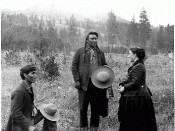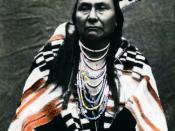Abstract
The story of Chief Joseph exemplifies the disastrous result when a situation is influenced and controlled by an ineffectual leader such as General Howard who had been matched against an effective leader such as Chief Joseph. Chief Joseph valued ethics and continuously involved his people in the discussions and decisions that affected their tribe. General Howard was relentless in his autocratic, authoritative, directive manner of leadership which allowed him never to accomplishment his task of removing the Indians to the reservation. The Nez Perces Indians were not removed by General Howard. They did not go until the decision was made by Chief Joseph that in order to preserve the strength and lives of his people, they had to surrender and proceed to the reservation.
Chief Joseph: Saving Indian Values
The leadership styles and lack of leadership skills shown by General Howard made a difficult situation even harder.
His harsh implementation of orders to remove the Indians did not give himself or Chief Joseph a means by which a more peaceful solution could have been found. Much hardship and death occurred while these two leaders were exerting their own style of leadership. Even though each of their leadership styles differed greatly, they showed determination and dedication to their perceived goals.
Nez Perces Society and Values
The Nez Perces were made up of smaller bands all rich in culture, ethics, and values. Disagreements that surfaced were resolved by open debates with no time frame. These Indians demonstrated realism for they, "included everyone views and encourages people to speak up. Resulting conclusions are typically more sensible" (Draft, 200, p. 261). Nez Perces people held the same spiritual beliefs and fundamental views on life. They valued honesty, equality, respect for others, and loyalty. There decisions were based upon tribal ethics.
The Indians' success on the battlefield was due to the fact of their strong culture. According to Daft (2002), culture strength is present when there is agreement among people about the importance of certain values and methods of doing things (515). On the battle field the Nez Perces viewed themselves as a whole that were committed to each other. They were not fighting for themselves but fighting for each other to help keep their society together. This goal commitment from Chief Joseph's people resulted in essential performance on the battle field. "When commitment is high, difficult goals result in higher performance" (McFarlin and Sweeny, 2002, p.101).
Conflict
The white people began to impose on the Indian's land claiming the United States owned it. Chief Joseph went to a treaty council to reinforce that he never sold his land and his people would not fit on the proposed reservation. He declared that they were happy where they were presently living and did not intend to move (p. 6, 11. 84-110). His words feel on deaf ears for it was during a treaty council with General Howard, the conflict reached its climax. After being previously told by the general that they could stay on their land, the Nez learned that the general's worlds were a lie. An ultimatum was given to the Indians to remove themselves from their land in 30 days or there would be a war (p. 8, 11. 93-110). Chief Joseph and he people wanted no such thing. General Howard was not understanding or empathetic to the Chief Joseph's concern for his fellow people. Chief Joseph earnestly explained that he could not move his people in that short amount of time only to have the General retort, "if you let time run over one day, the soldiers will be there to drive you on the reservation" (p.8, 11. 93-110). Being he was an authoritative leader, the general approached the issues with no concern for others. The Nez Perces were left with no choice but to start the tedious task of moving from the land they called home.
The decisions of the white people confused and affected the Nez Perces in numerous ways. For thousands of years generations of Nez Perces had lived on this land. They did not understand the strangers coming into their land demanding them to move because the land now belonged to them. These white people were taking away something that was sacred to the Indians and in its place leaving uncertainty for their future. When asked who gave them the right to take this land, the white people could not provide an answer. This left the Nez Perces even more bewildered.
Leadership
Chief Joseph
Foremost, Chief Joseph's leadership was values-based which focuses on the relationship between the leader and the followers. "It is based on shared, strongly internalized values that are advocated and acted upon by the leader" (Draft, 2002, p. 530). These leaders are strongly committed to ethical conduct and are influenced by their spiritual beliefs.
Chief Joseph viewed himself as an equal. He learned to control his temper when angry and learned to talk his people out of acting irrationally when they were angered. People followed him because they trusted him and viewed him as an equal... He had self-insight; he knew his strengths and weaknesses; he had courage (McFarlin and Sweeney, 2002, p. 8-9). These traits helped make him an effective leader.
At the same time Chief Joseph was a democratic leader for he sought input, information, ideas, and opinions from his people before final decisions were made (Bateman and Snell, 2002, p.374). He arrived at decisions by using a behavioral style of decision making. Chief Joseph was attuned to how his decisions would impact his whole tribe. He was analytical and rational in his approach to decisions. At the same time he understood the "big picture" and for that he was conceptual (.McFarlin and Sweeney, 2002, p. 126). Chief Joseph regarded the future for his people the most important and therefore displayed utilitarianism. According to Bateman and Snell (2002) utilitarianism seeks the greatest good for the greatest number of people (139).
His decisions were guided by ethics.
He also demonstrated moral leadership. These types of leaders are familiar with themselves, recognize their own strengths and weaknesses, and have courage to be innovative and stand for what they believe in (Draft, 2002, p.224). They have to be able to recognize the superior abilities of others.
General Howard
General Howard's decisions and the manner in which he carried out his orders showed him to harbor all the traits of an autocratic leader. His authoritarianism lead him to believe that power and status differences should exist and established authority should be obeyed (Draft, 2002, p.124). He was highly dogmatic because he was closed minded and not receptive to others ideas because it conflicted with his opinion. Since he used power for his own good, he can be thought of as a personalized leader (Draft, 2002, p. 456).
His directive style of decision making did not cope with a lot of details, contemplate about the larger implications of their decisions, or take the time to reflect on excess information (McFarlin & Sweeny, 2002, p. 126). No where is it evident that the General wavered in his determination to carry out orders to consider the consequences of his actions. He was demanding and lacked empathy in his dealings with the Indians. If he had taken the time to consider the Indians' position and feelings, he might have been more inclined to approach the situation differently. He was unsuccessful in moving the Nez Perces to the reservation because of his lack of effective leadership.
Conclusion
The Indians were not shown fairness. To the Nez Perces it seemed with each effort put forth, they received nothing. They were told many different things by the white people, all which they believed, only to have these white people go back on their word. Even though they were lied to, the Indians eventually complied with the white people to move to the reservation. To preserve the strength and life of his people, Chief eventually made the decision to surrender. Too many of his people had suffered hardship and death fighting the white people.
The Indians openly stated their willingness to work with the white people in order to reach other alternatives. These pleas were ignored. If General Howard had taken the time communicate openly and honestly with the Nez Perces a lot of blood shed could have been prevented, but he only dismissed this idea each time it was brought up. He allowed his preconceptions, stereotypes, and ethnocentrism to guide his actions. He should have been willing to work with them instead of against them. The lack of effective leadership skills caused war and unnecessary death.
References
Draft, R. (2002). The Leadership Experience (2nd ed). Ohio: South Western-Thomson.
Bateman, T., & Snell, S. (2004). Management: The New Competitive Landscape. New York:
Irwin-McGraw Hill.
McFarlin, D., & Sweeny, P. (2002). Organizational Behavior: Solutions for Management. New
York: Irwin-McGraw Hill.
The Hartwick Humanities in Management Institute. (2001). Classic Leadership Cases.
An Indian's View of Indian Affairs. New York: Author


